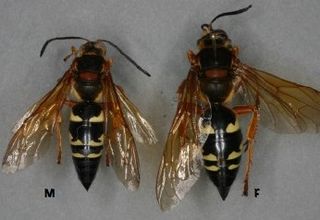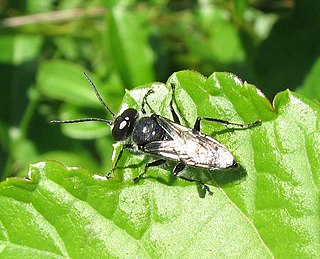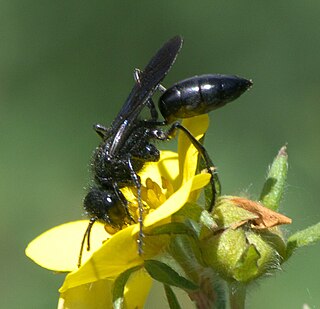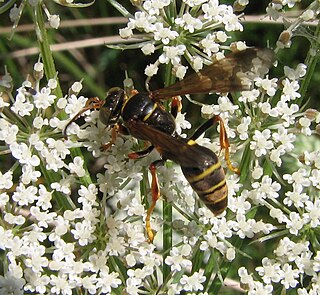
Sphecius speciosus, the eastern cicada-killer wasp, is a large, solitary digger wasp species in the family Bembicidae. They are so named because they hunt cicadas and provision their nests with them. Cicada killers exert a measure of natural control on cicada populations, and as such, they may directly benefit the deciduous trees upon which the cicadas feed. Sometimes, they are erroneously called sand hornets, despite not truly being hornets, which belong to the family Vespidae.

The horse guard wasp is a type of sand wasp (Bembicini) from the eastern United States which preys primarily upon horse-flies (Tabanidae). It is a large, colorful, fast-flying wasp, one of 28 species in the genus Stictia, all of which have similar biology.

Pemphredonidae is a family of aphid wasps formerly treated as the subfamily Pemphredoninae. There are 19 genera and 556 described species in the family.

The Australian cicada killer wasp, Exeirus lateritius, the sole member of the genus Exeirus, is a large, solitary, ground-dwelling, predatory wasp. It is related to the more common genus of cicada killers, Sphecius. In Australia, E. lateritius hunts over 200 species of cicada.

Astata is a cosmopolitan genus of solitary predatory wasps in the family Astatidae. They are known to prey on adults and nymphs of Pentatomidae. Astata is the largest genus in this subfamily, and is identified by features of its wing venation. The males of this genus and the related genus Dryudella have very large compound eyes that broadly meet at the top of the head.

Sphecius grandis, also called the western cicada killer, is a species of cicada killer wasp (Sphecius). The western species shares the same nesting biology as its fellow species, the eastern cicada killer. S. grandis, like all other species of the genus Sphecius, mainly provides cicadas for its offspring. It forms nest aggregations and mates and broods once in a year, in July and early August. The wasp is on average 3 cm (1 in) to 5 cm (2 in) in length and is amber-yellow with yellow rings on its abdomen.
Lynn Siri Kimsey is an entomologist, taxonomist, director of the Bohart Museum of Entomology and professor of entomology at the University of California, Davis since 1989. Her specialties are bees and wasps; and insect diversity and evolution.
Richard Mitchell Bohart was an American entomologist, university professor, and a member of the University of California, Davis Department of Entomology for more than 50 years. He taught courses in general entomology, insect systematics, and summer field courses in insect identification. From 1963 to 1967 he served as chair of the Department of Entomology for the University of California at Davis.
Leucodynerus is a Nearctic genus of small sized potter wasps distributed in south western United States and northern Mexico.
Pleurochrysis is a genus of cuckoo wasps from the New World, with 36 species distributed from Mexico to Argentina. One species is a parasitoid of the potter wasp Cyphomenes anisitsii.

Podalonia is a genus of parasitoidal wasps in the family Sphecidae.

Crabro is a genus of square-headed wasps belonging to the family Crabronidae. There are at least 80 described species in Crabro, found in the Nearctic and Palaearctic (Holarctic).
Palmodes is a genus of thread-waisted wasps in the family Sphecidae. There are more than 20 described species in Palmodes.

Ammoplanops is a genus of aphid wasps in the family Ammoplanidae. There are about 15 species described in the genus Ammoplanops.
Larropsis is a genus of square-headed wasps in the family Crabronidae. There are more than 40 described species in Larropsis.

Saygorytes is a genus of sand wasps in the family Bembicidae. There are about seven described species in Saygorytes.
Elampus cecchiniae is a species of wasp in the cuckoo wasp family (Chrysididae). The species was first described in 1967 by A. P. Semenov-Tian-Shanskij as Notozus cecchiniae and transferred to the genus Elampus in 1991. The holotype is a male that was found in Turkmenistan.

Euparagia is a genus of wasps in the family Vespidae, the only extant genus in the subfamily Euparagiinae.

Parancistrocerus declivatus is a species of potter wasp native to the southern coastal counties of California and Baja California in North America. This wasp was originally categorized in the genus Stenodynerus. The type locality was La Laguna, Sierra Laguna, Baja California.

Argochrysis is a genus of cuckoo wasps in the family Chrysididae. There are about five described species in Argochrysis.












